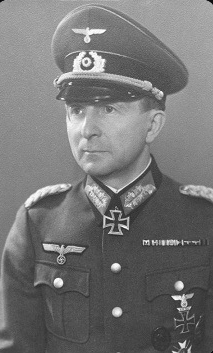Angern, Günther
- Date of birth:
- March 5th, 1893 (Kolberg/Pomerania, Germany)
- Date of death:
- February 2nd, 1943 (Stalingrad/Stalingrad Oblast, Soviet Union)
- Nationality:
- German
Biography
Born in Kolberg, Angern joined the army of Imperial Germany as an Fahnen-junker (officer cadet). He was commissioned in the infantry and fought in World War I. In the interwar period, he joined the Wehrmacht and by 1938 was commander of the 3rd Schützen (Rifle) Brigade. The following year he led the 11th Schützen Brigade. In August 1940, now an oberst, he was awarded the Knight's Cross of the Iron Cross while commanding the brigade.
On 15 August 1941, during the later stages of Operation Barbarossa, Angern was given command of the 11th Panzer Division. His time leading the division was brief, for he was wounded nine days later. He had a long period off active duty because of his wounds and during this time was promoted to generalmajor and received the German Cross in Gold.
Returning to duty on 15 September 1942, Angern took command of the 16th Panzer Division, operating to the north of the city of Stalingrad, supporting the divisions fighting in the city. By mid-November, the division had been reduced to 4,000 personnel and had been ordered to withdraw to the Donets. The Red Army began a counteroffensive which encircled Stalingrad, trapping several elements of the division, including Angern and his staff, in the city along with the Sixth Army. Angern remained in Stalingrad throughout the siege and was promoted to generalleutnant on 21 January 1943.
The advance of the Red Army pressed the Germans into the eastern portion of the Stalingrad perimeter and in mid-January, along with some other staff officers of the division, Angern considered escaping the encirclement by passing through the frontlines wearing captured Red Army uniforms accompanied by Russian Hiwis. Nothing came of the plan and, with defeat inevitable, Angern committed suicide on 2 February 1943.
Promotions:
1st April 1911: Fahnenjunker;
20th February 1912: Fähnrich;
18th November 1912: Leutnant;
22nd March 1916: Oberleutnant;
1st October 1922: Rittmeister;
1st April 1933: Major;
1st October 1935: Oberstleutnant;
1938: Oberst;
1st September 1941: Generalmajor;
21st January 1943: Generalleutnant.
Do you have more information about this person? Inform us!
- Period:
- Second World War (1939-1945)
- Rank:
- Major
- Awarded on:
- 1934
- Period:
- Second World War (1939-1945)
- Rank:
- Oberstleutnant (Lieutenant-colonel)
- Awarded on:
- October 2nd, 1936
- Period:
- Second World War (1939-1945)
- Rank:
- Oberst (Colonel)
- Awarded on:
- October 26th, 1938
- Period:
- Second World War (1939-1945)
- Rank:
- Oberst (Colonel)
- Awarded on:
- September 18th, 1939
- Period:
- Second World War (1939-1945)
- Rank:
- Oberst (Colonel)
- Awarded on:
- October 9th, 1939
- Period:
- Second World War (1939-1945)
- Rank:
- Oberst (Colonel)
- Awarded on:
- 1939
- Period:
- Second World War (1939-1945)
- Rank:
- Oberst (Colonel)
- Unit:
- Kommandeur, 11. Schützen-Brigade, Heer
- Awarded on:
- August 7th, 1940
1.) Capturing the bridges at Anzien and St. Catharine, north of Arras (23.05.1940).
2.) Seizing the castle of Westcappel against heavy British resistance (28.05.1940).
3.) Creating a bridgehead over the Bresle at Pont et Marail (05.06.1940).
4.) Successfully forming another bridgehead over the Bethune river at St. Aubin and Dampierre (10.06.1940).
145th Award.
Entered: 18th July 1940.
Confirmed: 26th July 1940.
Granted: 5th August 1940.
Preliminary Award document and decoration dated on 7th August 1940.
- Period:
- Second World War (1939-1945)
- Rank:
- Oberst (Colonel)
- Awarded on:
- July 7th, 1941
- Period:
- Second World War (1939-1945)
- Rank:
- Oberst (Colonel)
- Unit:
- Kommandeur, 11. Schützen-Brigade, Heeresgruppe Süd
- Awarded on:
- July 22nd, 1941
- Period:
- Second World War (1939-1945)
- Rank:
- Generalmajor (Brigadier)
- Unit:
- 11.Panzer-Division, 4.Panzer-Armee, Heeresgruppe Mitte
- Awarded on:
- March 8th, 1942
Entered: 20th February 1942.
Confirmed: 25th February 1942.
Awarded: 8th March 1942.
- Period:
- Second World War (1939-1945)
- Period:
- Second World War (1939-1945)
- Period:
- Second World War (1939-1945)
- Period:
- Second World War (1939-1945)
- Period:
- Second World War (1939-1945)
- Period:
- Second World War (1939-1945)
- Period:
- Second World War (1939-1945)
- Period:
- Second World War (1939-1945)
- Period:
- Second World War (1939-1945)
Sources
- Photo 1: puvblic domain
- - FELLGIEBEL, W.P., Elite of theThird Reich, Helion & Company Limited, Solihull, 2003.
- PATZWALL, K. & SCHERZER, V., Das Deutsche Kreuz 1941-1945, Verlag Klaus D. Patzwall, Norderstedt, 2001.
- THOMAS, FRANZ & WEGMANN, GÜNTER, Die Ritterkreuzträger der Deutschen Wehrmacht 1939-1945, Biblio-Verlag, Osnabrück, 1987.
- De Slag om Stalingrad
- Axis History Biographical Research via Axis History Forum
- Karteikarten RK/DKiG, Bundesarchiv
- TITLE





















